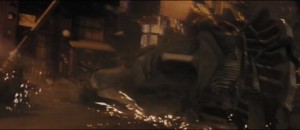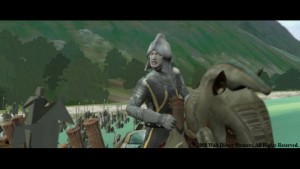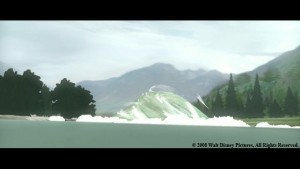Third Floor started as the third floor pre-viz department at Skywalker ranch. Now a separate company, Third Floor is a pre-viz and post-viz specialist. In this week’s fxpodcast we talk to CEO Chris Edwards about their recent work on Narnia, and explore their filmic approaches to previz. We also present Edward’s play book for successful pre-viz along with some client survival tricks.
The Australian members of the Visual Effects Society presented an evening with Chris Edwards, CEO and pre-viz supervisor of The Third Floor. The company, born out of George Lucas’ Skywalker Ranch, provides a unique approach to the pre-viz process which is increasingly being used by film directors and game developers to create their most ambitious productions.
The Third Floor has worked to expand the traditional role of pre-viz beyond staging complex visual effects shots. Edwards showed how to approach pre-viz with numerous case studies including Star Wars: Episode III, Cloverfield and elaborate commercials and game cinematics that the team has designed.
This discussion took the attendees inside a pre-viz scene file and revealed tips and tricks that can make pre-viz more convincing and more useful on-set. The general definition of pre-viz is “a 3D computer animated representation that is created prior to the final implementation of an artistic endeavor or technical challenge,” according to Edwards.
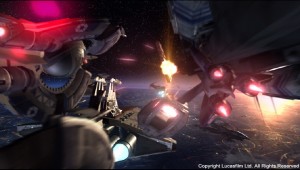 Edwards sees pre-viz as a classic win win for directors and producers. “It works creatively, saves money and helps convey their vision to the entire cast and crew…endeavors that would have otherwise not been possible”, Edwards explains. He points out that pre-viz can also be used to raise money and get a film green-lit. Not simply small amounts of money, but “Lord of the Rings budgets,” he explains in this week’s fxpodcast.
Edwards sees pre-viz as a classic win win for directors and producers. “It works creatively, saves money and helps convey their vision to the entire cast and crew…endeavors that would have otherwise not been possible”, Edwards explains. He points out that pre-viz can also be used to raise money and get a film green-lit. Not simply small amounts of money, but “Lord of the Rings budgets,” he explains in this week’s fxpodcast.
Directors and studios historically rely on storyboards. These could sometimes be filmed as animatics/story reels or board-o-matics, but it was effectively based on still photography. In some cases such as Star Wars Episode V, a lipstick camera was used through a model or miniature to create an animatic, but this was the exception rather than the rule at this point in time.
This has all changed with pre-viz. The advent of cost-effective and very fast computer graphics has completely opened up the options for film makers. In the beginning, CGI software was used just to solve vfx problems, but eventually it was used outside vfx for conceptual and technical pre-viz.
Chris Edward’s Background
Edwards attended film school and then went straight to Disney as a 3D layout artist and character animator, working on animation on such films as Dinosaur and Treasure Planet. There was a great number of talented traditional layout supervisors working at Disney who inspired him. They would say “‘Chris… make your angles more dynamic… push it!'” he recalls. While at Disney, he also learned that feature film development was expected to be relatively inefficient. “The potency of the original vision was often lost throughout the process…the producer was often embarrassed to show what they were doing,” Edwards recalls.
Lucasfilm found him and invited him to join the Force. He recalls that Lucasfilm does not advertise and instead “they kind of find you – like in the Matrix.” At Lucasfilm, the team was literally on the third floor at Skywalker Ranch where they got to work closely with Lucas, especially after he told Lucas, “we are making your film up there, you should come up!” The team was six to eight concept artists and ten pre-viz artists – all maya generalists with one specialist skill so they could learn from each other.
Initially the team was put together for THX 1138, with 48 minutes of enhanced footage. These ranged from set extensions to adding CG characters and removing midgets. To do some set extensions the crew needed more actors, but with none planned for, the third floor team ended up filming themselves. “You had our teams with shaved heads, watching THX, comping ourselves into THX – looking like we were from THX with headphones on in the office,” Edwards recalls.
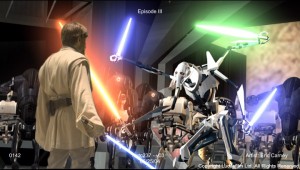
For Star Wars Episode III the third floor of Skywalker ranch did 7000 iterations of shots — in other words, they made the equivalent of the whole film three times over. One interesting aspect that Edwards recounts from his time on Star Wars was how Steven Spielberg ended up directing several scenes in the film. Apparently Spielberg knew that this would be his last chance to direct Star Wars and requested his friend to let him direct a few scenes. You can hear more about the Spielberg doodles in the fxpodcast.
Leaving Skywalker Ranch, the third floor group wanted to keep the team together. This did happen, as eight of the original ten stayed together as a team to work at Third Floor.
From his days of working at Skywalker Ranch, Edwards says he learned:
– the realities of live action
– the importance of the collaboration with art directors and concept designers
– the synergy between art department and pre-viz
To this last point, Edward feels that a very close link between the art department and pre-viz can help both areas. He points to shots where the pre-viz department would mock up an environment and then hand it to the art department who would then “grab a frame and draw over the top.” This allows for much more accurate shots with the addend bonus of the full artistic interpretation that only the art department can provide.
He also points to the benefits of working closely with an editor in both pre and post-visualization. For the pre-viz teams themselves, Edwards thinks small teams are essential for creativity, because it is very collaborative. “Larger teams require additional levels of communication – small teams can internally solve problems” he explains.
Because pre-viz is dealing with many issues, it is recommended that the technical pipelines for creating the actual pre-viz imagery be kept simple. At Third Floor, they use no specialist software or non industry standard code so that any key assets can be easily handed on to the various actual effects vendors. Also as important as the technical considerations, Edwards tries to make all of their staff feel personally responsible for the film, so it “really motivates us.”
The balance between technical and conceptual really depends “on who they are working for,” says Edwards. It could be that the Third Floor is working with one of many people on a film at any time, and these people serve different functions. For instance, on any one shot they could be servicing anyone from the director to production designer to the vfx supervisor or vfx producer.
Third Floor
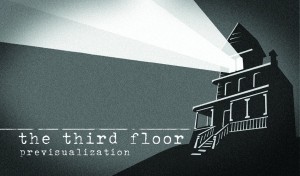 Third Floor operates in a business space between film and gaming. The company initially did work on video game cinematics as a way of bridging between film projects, but this quickly changed to being an important central platform of the company’s business plan.
Third Floor operates in a business space between film and gaming. The company initially did work on video game cinematics as a way of bridging between film projects, but this quickly changed to being an important central platform of the company’s business plan.
Third Floor is now based in Los Angles, with some 28 veteran pre-viz members on the team along with several professional story board artists. While coming from a film background, their initial work was in video game cinematics and now it includes TV commercials and feature films. The company can be working on five or seven projects simultaneously.
Games Cinematics
Games Cinematics is a powerhouse of the company. These projects tend to have four to seven people on the team and the company works directly for the game developer or publisher. Unlike films, many games have a large number of existing assets before the Third Floor team gets started. The emphasis is primarily on setting up interactive moments, staging dramatic sequences for in-engine playback and working with motion capture data.
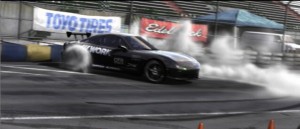 Each of these projects can take several months. Some of their work includes:
Each of these projects can take several months. Some of their work includes:
- Lost Odyssey
- Command and conquer
- Lair Playstation release (Dragon riders)
- ‘Need for speed’ PROSTREET EA
- Starcraft 2
- Resident Evil 5
In the case of Lair, the team produced one to three shots per day once assets were built. They were commissioned by Sony’s internal cinematics team and asked to help refine it as a sequence. Ultimately the team ended up taking their work all the way to final with the exception of the actual rendering.
Sometimes the team is drawn upon for the game and sometimes for the trailer, promotion or even proof of concept. In Need for Speed the team explored the way simulation of crashes could be used and their work ended up in the trailer (although actually finally done elsewhere).
TVC pre-viz
The Third Floor also works in commercials (
view their pre-viz TVC reel), which tend to be fast-paced with only two to four week engagements for a team of only two or three artists. Often, the shots and schedules are so tight that the team is invited to come on set and continue working during filming to make sure the live action plates are shot correctly for what has been worked out during pre-viz.While pre-viz is used traditionally, Third Floor has also been asked to help with pitch videos that are done before an account or project is even awarded. One such case was the Jeep Compass account. Before it was awarded, the multi-million dollar campaign started life as a pre-viz project by the Third Floor. They developed a whole look that was then used as the basis of the pitch and also separately made into a final spot.
In the case of the Pepsi Pinball spot with method studios, Third Floor did all of the pre-viz with a high degree of accuracy. In the spot, San Francisco is used as a giant pinball machine, and Third Floor did the pre-viz and on set consulting with a full GPS map of the shoot showing exactly how and where each shot should be done in the city.
Feature Films
The Third Floor worked on – or had team members very heavily involved with– previsualization on almost the whole film for Cloverfield and The Chronicles of Narnia: Price Caspian (
view their pre-vis feature reel). Teams for feature film work tend to be around six to nine artists, usually hired by the vfx department. The project generally run from three to five months but some last for over a year. On longer projects, the numbers can balloon up and ramp down at the end as specialists come and go.There is a large trend to ‘post-viz’ which is defined to be similar to pre-viz but done after principle photography.
For example the team did post-viz on Eragon. The actual plates were shot in Prague and the Third Floor team then tracked them and added various cg characters for the editor and the studio. “It is an extremely useful tool for editing and test screening complex visual effects sequences, and the imagery can be used to simplify the final VFX bidding process.” Edwards explains.
The team has worked on many feature films :
• Beowulf
• The Happening
• Cloverfield
• Eragon
• Chronicles of Narnia, Prince Caspian
Plus several films yet to screen, or still in production:
• Avatar
• Star Trek
• Starship Dave
• Chronicles of Narnia: The voyage of the Dawn Treader
• X-men Origins: Wolverine
Cloverfield
On this film, Third Floor was only ‘given the call’ five days before principle photography. Literally, the studio knew that within a week they would have over 200 extras on a street on the Warner’s backlot. This was so successful that for each major shot, the principle first unit ended up starting on set by saying, “what are we doing?…OK, lets look at the pre-viz” for most sequences in the film.
Chronicles of Narnia, Prince Caspian
Edwards explains that for this film, they “put a lot of work in on our camera.” The team uses real world camera motion, and a “mix of what we had on Star Wars and what we have developed since.” Even with the scene complexity that the Third Floor provides, everything has to be able to be play-blasted and run in real time.
Third Floor’s team was very involved with not only pre-vizing storyboards, but active in story and cinematic discussions. An example would be discussions about the battle sequences in the film and the director’s desire not to repeat scenes from the first Narnia offering. From this discussion, the whole idea of the underground cave collapse was floated. This, of course, made it into the final cut and adds a very different and dramatic twist to the large open field battle sequence in Prince Caspian.
Another interesting story is that the studio was worried about the River God sequence — so much so that they were thinking of maybe cutting the scene. So the sequence was given back to the Third Floor and they comped pre-viz into live action plates from first unit. This led to the scene being kept in the film and the post-viz shots were then sent on to Scanline visual effects in Germany (who now have offices in LA) to give them a head start on the sequence.
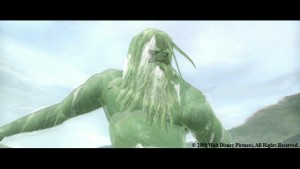
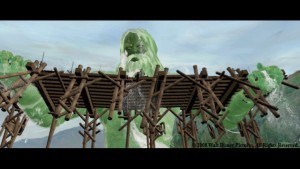
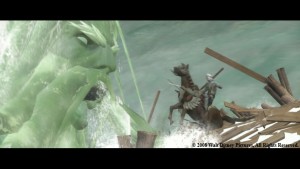
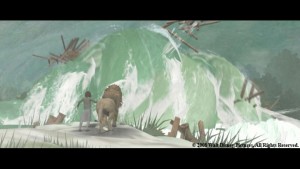
The Process of Pre-viz
Here is Chris Edwards Pre Viz guide book to the process of pre-viz.
- Get reference — any reference.
- Get assets. This includes buying assets but also building a library. By buying modeling libraries, you don’t have to build everything from scratch.
- Pay attention to scale. Once a shot is handed off, the vfx house will need accurate measurements.
- Get accurate lens settings and camera settings. Try and use only lenses that could be used on the real shoot.
- Block it out first without animation. Do a series of static compositions in the same scene file. Get feedback and rough it out some more. Make sure you block with posed figures – as it will affect framing. “Sweeten the blocking and really work on the plan before you put the love into it” Don’t cheat until you have to, but rather keep based in reality. Don’t allow the camera to move through the floor or wall…”go as far as you can, and only then push it”
- Next, with still compositions work out the timing and how the characters are moving through the frame. They need to be posed before you frame up. The timings need to be realistic…in fact “the timing needs to be dead on or pretty close”
- Maintain an edit and watch your work in context. Take a step back and think about what is needed.
- Don’t underestimate the power of basic lighting and colour choices but limit your work to eight basic lights so that you can maintain realtime lighting.
- Art direction should be included as much as you can.
- Add canned effects, and don’t underestimate how powerful cards can be in 3D for doing good pre-viz. “Use pre-viz as a template for the final, maintain the edit and swap in high res assets. This should free you up to focus on the artistry of the details”
Notes:
- Use real world dimensions as much as possible
- Use tricks like shadow cards
- No skinning to keep it fast
- Use moving cards not particles for smoke, dust water (planes moving and rotating)
- Set up multiple cameras on the one animation
Survival Tips
- Be prepared for anything
- Always present best idea first
- Don’t push your director too hard: they need things to be their ideas
- Present their way first AND your way. Know your client and know their style. Rent all their student films, watch anything they have done — the earlier the better
- Naming conventions are important, especially as you hand off work.
- Level of detail: save the heavy asset for the final and only build what you think you’ll need
- Rig the same way every time so your library has maximum re-usability.
- Save and categorize everything to be able to find your personal assets.
- Don’t use proprietary tools. Use Maya and Motion Builder
- Use hardware rendering
- Capture high at highres over-render and scale down
- Use ReelSmart motion plugin for motion blur in After Effects
- Care about cheated depth of field

